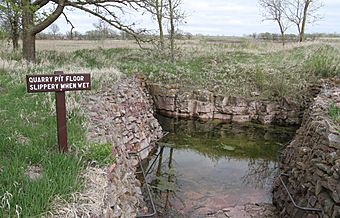Pipestone National Monument facts for kids
|
Pipestone National Monument
|
|
 |
|
| Location | Sweet Township, Pipestone County, Minnesota |
|---|---|
| Nearest city | Pipestone, Minnesota |
| Area | 281.78 acres (1.14 km2) |
| Visitation | 73,267 (2019) |
| Website | Pipestone National Monument |
| MPS | Pipestone County MRA (AD) |
| NRHP reference No. | 66000112 |
Quick facts for kids Significant dates |
|
| Designated HD | October 15, 1966 |
| Designated NMON | August 25, 1937 |
Pipestone National Monument is a special place in southwestern Minnesota. It's located near the city of Pipestone, Minnesota. This area is very important to 23 different Native American tribes.
For thousands of years, people have come here to quarry a unique red stone. This stone is called catlinite, or "pipestone." It's traditionally used to make ceremonial pipes. These pipes are a big part of Plains Indian traditions.
Long ago, the quarries were seen as a neutral territory. This meant all tribes could safely come to get the stone. Archeologists believe people have used this site for over 3000 years. Pipestone from Minnesota has even been found in ancient North American burial mounds far away.
Contents
A Look Back in Time
Early History of the Quarries
From the 1400s to the 1700s, the Iowa people lived near these quarries. Later, by the late 1700s, the Sioux tribes became the main group in the area.
In 1849, a piece of pipestone was sent to the Washington Monument in Washington, D.C.. This red stone is called ínyanša in the Dakota language.
Protecting the Sacred Land
In 1851, some Dakota bands signed a treaty. This treaty gave parts of southwest Minnesota to the U.S. government. However, the Yankton people also claimed some of this land. They were not part of that treaty.
To keep their access to the quarry, the Yankton Dakota signed their own treaty in 1858. This treaty gave them a special one-mile square area around the quarry. This area was meant to protect their right to the pipestone.
Over time, settlers moved onto this land. In 1891, the U.S. government took 100 acres from the Yankton's reservation. They used it to build the Pipestone Indian School. The Yankton tribe fought this in court. In 1926, the U.S Supreme Court agreed with them. The court ordered that the tribe be paid for their land.
Becoming a National Monument
On August 25, 1937, the area officially became a National Monument. The law that created it made sure Native Americans could still quarry pipestone. Today, any member of a federally recognized American Indian tribe can get a permit to dig for the stone.
The National Park Service works closely with 23 different tribal nations. They discuss how to manage the land and preserve its history. The historic area is known as "Cannomok'e—Pipestone National Monument." "Cannomok'e" means "pipestone quarry" in the Dakota language.
Making Pipestone Pipes
The Art of Pipemaking
Inside the monument's visitor center is the Upper Midwest Indian Cultural Center. During the summer, you can watch Native craftworkers make pipes. They use the pipestone from the quarries.
These artists use special techniques passed down through their families. Many are third or fourth-generation pipe makers. They show how the stone is carved into beautiful ceremonial pipes.
The Smithsonian Institution's National Museum of the American Indian has many pipestone items. It has over 700 objects, with more than 500 of them being pipes.
What to See and Do
Exploring the Monument's Trails
Visitors can walk a three-quarter mile (1.2 km) trail. This trail lets you see the pipestone quarries and a beautiful waterfall. You can get a guide at the visitor center to help you explore.
Nature and Wildlife
About 260 acres (1.05 km2) of the monument is a restored tallgrass prairie. This means it looks like the natural grasslands that used to cover the area. Park staff use controlled burns to help the native grasses grow. This also helps control weeds.
This prairie is home to many animals. You might see birds like the bobolink and eastern kingbird. Not far away, at Blue Mounds State Park, you can find more tallgrass prairie and a small bison herd.
Visitor Center Exhibits
The visitor center has exhibits about the monument's history and nature. You can learn about the petroglyphs (ancient rock carvings) found around the quarry. There's also a video that tells the story of the pipestone quarries.
See also












